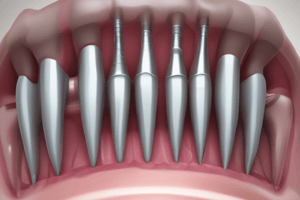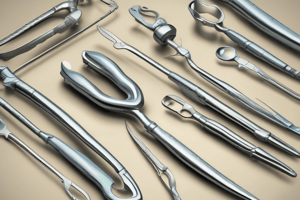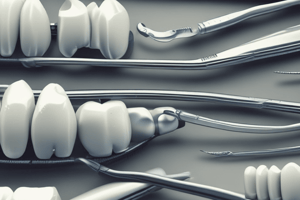Podcast
Questions and Answers
What is the primary use of the Ordinary Hatchet in dental procedures?
What is the primary use of the Ordinary Hatchet in dental procedures?
- Planning tooth preparation walls
- Forming line angles in Class III cavities
- Creating grooves in enamel
- Preparing retentive areas and sharpening internal line angles (correct)
Which cutting instrument has a cutting edge that is perpendicular to the axis of the handle?
Which cutting instrument has a cutting edge that is perpendicular to the axis of the handle?
- Angle Former
- Ordinary Hatchet
- Hoe (correct)
- Spoon
What is a common characteristic of the Angle Former?
What is a common characteristic of the Angle Former?
- Designated for creating retentive features and defining line angles (correct)
- Used primarily for Class II cavity preparations
- Identified by its straight cutting edge along the handle axis
- Used for flat tooth surfaces only
Which cutting instrument subdivision is used primarily on anterior teeth?
Which cutting instrument subdivision is used primarily on anterior teeth?
How are dental instruments commonly classified?
How are dental instruments commonly classified?
What is the primary function of a spoon excavator?
What is the primary function of a spoon excavator?
How is the blade width of a straight chisel expressed?
How is the blade width of a straight chisel expressed?
What type of chisel is described as having a bevel on only one side?
What type of chisel is described as having a bevel on only one side?
Which instrument is used primarily for cutting enamel?
Which instrument is used primarily for cutting enamel?
Which type of chisels is characterized by having a straight shank and a primary edge that is perpendicular to the handle axis?
Which type of chisels is characterized by having a straight shank and a primary edge that is perpendicular to the handle axis?
What is a distinguishing characteristic of the cleoid edge on the spoon excavator?
What is a distinguishing characteristic of the cleoid edge on the spoon excavator?
Which of the following tools is a combination of a gingival trimmer and a chisel?
Which of the following tools is a combination of a gingival trimmer and a chisel?
What does the first number in a four-number code for chisels represent?
What does the first number in a four-number code for chisels represent?
What is the primary purpose of a gingival margin trimmer?
What is the primary purpose of a gingival margin trimmer?
Which of the following is NOT a result of using dull hand-cutting instruments?
Which of the following is NOT a result of using dull hand-cutting instruments?
What type of sharpening stone is preferred for fine sharpening of dental instruments?
What type of sharpening stone is preferred for fine sharpening of dental instruments?
Which material is preferred for fine sharpening stones due to its properties?
Which material is preferred for fine sharpening stones due to its properties?
When using a stationary sharpening stone, what technique helps prevent rolling and dipping of the instrument?
When using a stationary sharpening stone, what technique helps prevent rolling and dipping of the instrument?
What feature distinguishes mechanical sharpeners from stationary sharpening stones?
What feature distinguishes mechanical sharpeners from stationary sharpening stones?
Why is it important to use light strokes when sharpening instruments?
Why is it important to use light strokes when sharpening instruments?
Which of the following properties applies to silicone carbide as a sharpening material?
Which of the following properties applies to silicone carbide as a sharpening material?
Which sterilization method is effective in preventing rust and corrosion of carbon steel instruments?
Which sterilization method is effective in preventing rust and corrosion of carbon steel instruments?
What is the consequence of using dull diamond burs during dental procedures?
What is the consequence of using dull diamond burs during dental procedures?
Which method helps to minimize discoloration and corrosion in sterilizing instruments?
Which method helps to minimize discoloration and corrosion in sterilizing instruments?
What is a purpose of using cylindrical fissure burs in dental procedures?
What is a purpose of using cylindrical fissure burs in dental procedures?
Which option is NOT a consideration in evaluating pulpal reaction?
Which option is NOT a consideration in evaluating pulpal reaction?
What is the function of a plain steel bur used under low speed?
What is the function of a plain steel bur used under low speed?
What can happen to the hardness of the alloy when using high heat sterilization?
What can happen to the hardness of the alloy when using high heat sterilization?
Which cutting instruments are recommended for retentive area placement?
Which cutting instruments are recommended for retentive area placement?
What is a key characteristic of diamond burs when cutting?
What is a key characteristic of diamond burs when cutting?
What method is used to control frictional heat during cutting?
What method is used to control frictional heat during cutting?
Which coolant is most popular among those mentioned?
Which coolant is most popular among those mentioned?
What happens to pressure when the speed increases during cutting?
What happens to pressure when the speed increases during cutting?
What is a disadvantage of using warm water as a coolant?
What is a disadvantage of using warm water as a coolant?
What role does air coolant play during cutting?
What role does air coolant play during cutting?
Which tapered bur is known to leave a rough surface?
Which tapered bur is known to leave a rough surface?
What effect does cutting at high speed have on heat production?
What effect does cutting at high speed have on heat production?
What is the primary function of the head of a dental bur?
What is the primary function of the head of a dental bur?
Which characteristic of a dental bur shank helps in maintaining alignment during operation?
Which characteristic of a dental bur shank helps in maintaining alignment during operation?
What advantage does the combination of air and water spray provide during dental procedures?
What advantage does the combination of air and water spray provide during dental procedures?
Which of the following is NOT an advantage of using rotary cutting instruments?
Which of the following is NOT an advantage of using rotary cutting instruments?
What does the bur classification system refer to with respect to dental burs?
What does the bur classification system refer to with respect to dental burs?
How does the proximity of the causative agents affect the pulp response during dental procedures?
How does the proximity of the causative agents affect the pulp response during dental procedures?
Which shape is NOT one of the basic head shapes of dental burs?
Which shape is NOT one of the basic head shapes of dental burs?
What type of application is recommended to minimize trauma during cavity preparation?
What type of application is recommended to minimize trauma during cavity preparation?
Flashcards
Excavator
Excavator
A dental instrument used for removing soft tissues (decay, dentin) from tooth preparations.
Ordinary Hatchet Excavator
Ordinary Hatchet Excavator
A type of excavator with a blade shaped like a hatchet. Its cutting edge is in the same plane as the handle, used for preparing retentive areas and internal line angles, especially on anterior teeth.
Hoe Excavator
Hoe Excavator
A type of excavator with a blade shaped like a hoe. Its cutting edge is perpendicular to the handle, used for planning tooth preparation walls and forming line angles, especially in Class III and V preparations.
Angle Former
Angle Former
Signup and view all the flashcards
Hand Condenser
Hand Condenser
Signup and view all the flashcards
Spoon Excavator
Spoon Excavator
Signup and view all the flashcards
Straight Chisel
Straight Chisel
Signup and view all the flashcards
Enamel Hatchet
Enamel Hatchet
Signup and view all the flashcards
Gingival Margin Trimmer
Gingival Margin Trimmer
Signup and view all the flashcards
Sickle Scaler
Sickle Scaler
Signup and view all the flashcards
Slightly Curved Chisel (Wedelstaedt)
Slightly Curved Chisel (Wedelstaedt)
Signup and view all the flashcards
Bin Angle Chisel
Bin Angle Chisel
Signup and view all the flashcards
Primary Cutting Edge Angle
Primary Cutting Edge Angle
Signup and view all the flashcards
Curved Excavator
Curved Excavator
Signup and view all the flashcards
Non-Cutting Instruments
Non-Cutting Instruments
Signup and view all the flashcards
Sharpening Hand Cutting Instruments
Sharpening Hand Cutting Instruments
Signup and view all the flashcards
Arkansas Stone
Arkansas Stone
Signup and view all the flashcards
Silicone Carbide (SiC) Stone
Silicone Carbide (SiC) Stone
Signup and view all the flashcards
Lay the stone on a flat surface
Lay the stone on a flat surface
Signup and view all the flashcards
Use a light stroke to prevent creation of heat
Use a light stroke to prevent creation of heat
Signup and view all the flashcards
Sterilization
Sterilization
Signup and view all the flashcards
Autoclaving
Autoclaving
Signup and view all the flashcards
Dry Heat Sterilization
Dry Heat Sterilization
Signup and view all the flashcards
Glass Bead Sterilization
Glass Bead Sterilization
Signup and view all the flashcards
Ultraviolet Light Sterilization
Ultraviolet Light Sterilization
Signup and view all the flashcards
Cold Sterilization
Cold Sterilization
Signup and view all the flashcards
Pulpal Reaction
Pulpal Reaction
Signup and view all the flashcards
What are diamond burs?
What are diamond burs?
Signup and view all the flashcards
How does the length of a diamond bur affect cutting?
How does the length of a diamond bur affect cutting?
Signup and view all the flashcards
Describe a tapered plain fissure bur and its use.
Describe a tapered plain fissure bur and its use.
Signup and view all the flashcards
What are tapered cross-cut fissure burs used for?
What are tapered cross-cut fissure burs used for?
Signup and view all the flashcards
How do you control heat generated during diamond bur use?
How do you control heat generated during diamond bur use?
Signup and view all the flashcards
What are the common coolants used with diamond burs?
What are the common coolants used with diamond burs?
Signup and view all the flashcards
When would you use air as a coolant?
When would you use air as a coolant?
Signup and view all the flashcards
What are the advantages and disadvantages of using warm water as a coolant?
What are the advantages and disadvantages of using warm water as a coolant?
Signup and view all the flashcards
Head (of a dental instrument)
Head (of a dental instrument)
Signup and view all the flashcards
Shank (of a dental instrument)
Shank (of a dental instrument)
Signup and view all the flashcards
Neck (of a dental instrument)
Neck (of a dental instrument)
Signup and view all the flashcards
Head shape
Head shape
Signup and view all the flashcards
Bur size code
Bur size code
Signup and view all the flashcards
Pulp response
Pulp response
Signup and view all the flashcards
Air/Water spray
Air/Water spray
Signup and view all the flashcards
Sharp instruments
Sharp instruments
Signup and view all the flashcards
Study Notes
Operative Dentistry Instruments
- Operative instruments are highly specialized tools used during dental procedures.
- Categories include: operative, prophylaxis, and general surgical instruments.
Cutting Instruments
- Hand-cutting instruments:
- Hatchets
- Chisels
- Hoes
- Excavators
- Rotary-cutting instruments:
- Burs
- Stones
- Discs
Condensing Instruments
- Hand condensers
- Mechanical condensers
Plastic Instruments
- Spatulas
- Carvers
- Cement carriers
- Burnishers
Finishing and Polishing Instruments
- Rotary: Finishing burs, mounted brushes, rubber cups, impregnated disks, and wheels
- Hand: Finishing strips, polishing points, orangewood sticks
Isolation Instruments
- Rubber dam frame
- Clamps
- Forceps
- Punch
- Saliva ejector
- Cotton roll holders
- Evacuation tips & equipment
Miscellaneous Instruments
- Mouth mirrors
- Explorers
- Probes
- Scissors
- Pliers
- Lubricant
Hand Cutting Instrument Design
- Blade/Nib: Functional end of the instrument (point or head)
- Handle (Shaft): Connects the blade to the shank. Early models were large and heavy, while modern ones are smaller and lighter.
- Shank: Connects the handle to the working end, the purpose of the shank is to balance the instrument. This is accomplished by adjusting the angulation of the shank so the cutting edge of the blade does not deviate from the axis more than 1-2 mm.
Cutting Instrument Bevels
-
Excavator:
- Ordinary Hatchets
- Hoes
- Angle forcer
- Spoons
-
Chisels:
- Straight
- Slightly Curved
- Enamel Hatchets
- Gingival margin trimmers
- Bin angle
-
Instrument Names: Classifications are based on function, manner of use, and working end design.
-
Examples: Scalers, excavators, spoon excavators, sickle scaler.
Sharpening Instruments
- Stationary Stones (Oilstones): Coarse, medium, and fine grit stones used for sharpening.
- Mechanical Sharpener: Honing machine that uses reciprocating motion with interchangeable honing tools.
Principles of Sharpening
- Clean and sterilize the instrument before sharpening.
- Establish the correct bevel angle.
- Apply light pressure to the stone.
- Minimize metal removal.
- Lightly hone the unexposed side of the blade.
- Resterilize the instrument.
Rotary Equipment
- Handpieces: Hold rotary instruments, power them, and position them intraorally. Categorized by speed: low, medium, and high/ultra.
Classification of Dental Burs
- Steel, Tungsten carbide, and Diamond: Differ in durability and efficiency at various speeds. Categorized by shape (round, inverted cone, straight, tapered).
Pulp Reaction to Rotary Cutting Instruments
- Heat generation during cutting may lead to pulp irritation.
- Instruments should be applied with care to minimize heat.
- Pulp response can be classified as mild irritation or severe injury.
Studying That Suits You
Use AI to generate personalized quizzes and flashcards to suit your learning preferences.
Related Documents
Description
This quiz covers the various types of operative dentistry instruments used in dental procedures. It includes categories such as cutting instruments, condensing instruments, plastic instruments, finishing and polishing instruments, isolation instruments, and miscellaneous tools. Test your knowledge on these essential dental tools!




